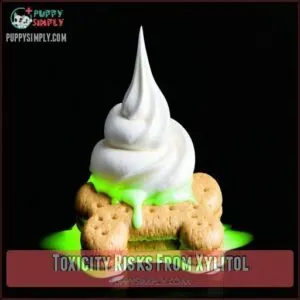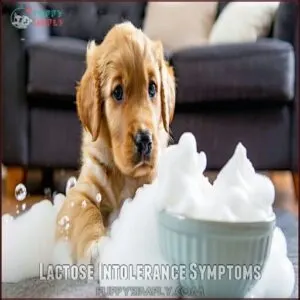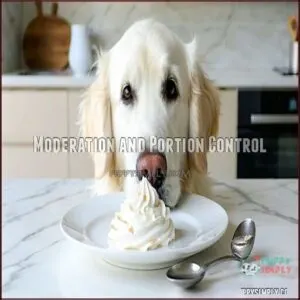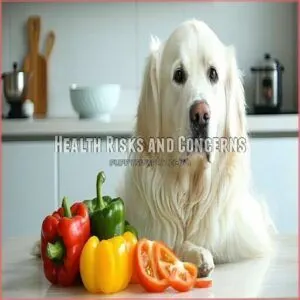This site is supported by our readers. We may earn a commission, at no cost to you, if you purchase through links.

Most whipped cream is safe if it’s just regular cream and sugar, but some brands contain xylitol, which is toxic to dogs.
Also, if your dog is lactose intolerant, even a small amount could cause an upset stomach, gas, or diarrhea.
Keep portions small to avoid unnecessary sugar, fat, or calorie intake, as these can lead to weight gain or pancreatitis over time.
If you’re unsure, stick with dog-safe alternatives like plain yogurt or fresh fruits. Sometimes, less is more in the case of treats!
Table Of Contents
- Key Takeaways
- Whipped Cream Basics
- Can Dogs Eat Whipped Cream
- Whipped Cream Safety
- Nutritional Value
- Feeding Whipped Cream Safely
- Health Risks and Concerns
- Whipped Cream Alternatives
- Frequently Asked Questions (FAQs)
- Can dogs eat too much whipped cream?
- Can dogs eat Light whipped cream?
- Can I give my Dog whipped cream?
- Can dogs eat vegan whipped cream?
- Can dogs eat chicken whipped cream?
- What happens if a dog eats whipped cream?
- Can I give a dog whipped cream?
- Is reddi whip okay for dogs?
- Is a pup cup just whipped cream?
- Is whipped cream bad for dogs?
- Conclusion
Key Takeaways
- Dogs can have whipped cream occasionally, but keep portions small and check for harmful ingredients like xylitol.
- If your dog is lactose intolerant, avoid whipped cream to prevent tummy troubles like gas or diarrhea.
- Regular whipped cream is high in sugar and fat, which can lead to weight gain or pancreatitis over time.
- Safer alternatives include plain yogurt, fresh fruits, or dairy-free options like coconut cream.
Whipped Cream Basics
Whipped cream is a light, fluffy topping made by whipping heavy cream with sugar and sometimes flavoring. It comes in different types, including homemade, store-bought, and aerosol can varieties.
Definition of Whipped Cream
Whipped cream is a fluffy topping made by whipping heavy cream until it’s light and airy.
Light, airy, and irresistibly creamy, whipped cream brings a touch of indulgence to any treat.
It’s a dairy product with a creamy base, often sweetened, highlighting its sugar content.
The whipping process gives its signature soft peaks.
With a high fat percentage, it’s a treat loved by many, though it offers little nutritional value.
Ingredients in Whipped Cream
It’s all about what’s inside! The whipped cream ingredients you know include:
- Cream: The base, loaded with fat, dairy, and a lush texture.
- Sugar: Sweetens the mix, but watch that sugar content for dogs.
- Flavorings: Vanilla’s a classic, enhancing the flavor.
- Preservatives: Extend shelf life but add unnecessary extras.
Always consider lactose intolerance or dairy alternatives for pups.
A safer option is coconut whipped cream, which is dairy-free.
Types of Whipped Cream
From store-bought canned whipped cream to silky homemade whipped options, there are many varieties.
Flavored whipped cream adds a tasty twist, while dairy-free options like coconut cream are kinder for lactose-intolerant dogs.
Low-fat whipped creams aim for fewer calories, but be cautious with sugar-free versions, as they often contain xylitol.
Not all whipped creams are created equal!
| Type | Key Feature | Concerns for Dogs |
|---|---|---|
| Dairy-based | Traditional ingredients | Contains lactose; high fat/sugar |
| Sugar-free | Lower sugar content | May include toxic xylitol |
| Coconut cream | Dairy-free alternative | Safer but watch portion sizes |
Can Dogs Eat Whipped Cream
You might wonder if it’s safe to share a small dollop of whipped cream with your dog.
While it’s not toxic in small amounts, the high sugar and fat content can lead to health issues over time.
Nutritional Value for Dogs
Considering dog nutrition, whipped cream offers limited nutrients and minimal dietary benefits.
Its caloric value might seem insignificant, but the fat content and sugar impact add unnecessary calories to your pet’s diet.
Canine nutrition requires protein and essential nutrients, which whipped cream lacks.
For pet nutrition, prioritize your dog’s dietary needs with healthier, high-quality options over sugary treats like whipped cream.
Some dogs experience issues because of lactose intolerance.
Potential Health Risks for Dogs
When treating your dog, it’s key to know the risks.
Whipped cream may cause digestive upset or trigger allergic reactions, especially in sensitive pups.
Be cautious of Xylitol poisoning in sugar-free versions—it’s toxic.
Overindulgence increases pancreatitis risk and obesity concerns, as its high fat content isn’t good for dogs.
Dogs with dietary sensitivities need safer alternatives.
Lactose Intolerance in Dogs
After discussing health risks, it’s essential to address lactose intolerance in dogs.
Many can’t process dairy due to limited digestive enzymes, leading to bloating, diarrhea, or gas. Breeds with sensitive stomachs face greater risks.
Here’s a quick glance at lactose intolerance:
| Concern | Symptoms | Solution |
|---|---|---|
| Dairy Digestion | Gas, diarrhea | Opt for Lactose Alternatives |
| Intolerance Symptoms | Upset stomach | Consult Veterinary Advice |
| Breed Predisposition | Sensitive breeds | Avoid dairy for dogs |
Whipped Cream Safety
You need to be cautious when giving your dog whipped cream, especially because certain ingredients can be harmful.
Sugar-free options often contain xylitol, a sweetener that’s toxic to dogs and can cause severe health issues.
Toxicity Risks From Xylitol
Xylitol, an artificial sweetener in some sugar-free whipped creams, poses serious dog toxicity risks.
Even tiny amounts can trigger xylitol poisoning, leading to rapid blood glucose drops, vomiting symptoms, and coma risk.
Severe cases may cause liver failure or death.
Watch for these signs:
- Weakness or tremors
- Vomiting or seizures
- Erratic behavior
- Coma-like unresponsiveness
- Symptoms escalating quickly, indicating a potential liver failure.
Dangers of Sugar-Free Whipped Cream
Sugar-free whipped cream may contain xylitol, a sweetener toxic to dogs.
Xylitol toxicity can cause low blood sugar, vomiting, or tremors, leading to liver failure or even coma risk.
Always check for artificial sweeteners in sugarfree options, as toxic ingredients can endanger your dog’s health, and to avoid these poisoning symptoms and potential dangers, stick to regular whipped cream, sparingly.
Lactose Intolerance Symptoms
Lactose intolerance in dogs often brings bloating and gas, an upset stomach, or diarrhea severity that can vary.
Your dog’s digestive system struggles to break down lactose, leading to food sensitivities or digestive upset.
Symptoms, like restlessness or discomfort, usually appear within hours, and if you notice these signs, avoid dairy and seek veterinary advice to manage food intolerance properly.
Nutritional Value
Whipped cream is high in fat and sugar, providing little nutritional value for your dog. While it contains small amounts of calcium and vitamin A, the risks outweigh the benefits.
Sugar Content in Whipped Cream
When thinking about whipped cream for dogs, sugar content matters. Sugar impacts dog health whipped cream treats by contributing to weight gain and dental issues.
It’s not ideal for dog nutrition. Keep portion sizes tiny and rare.
- Sugary whipped cream adds empty calories.
- Sweetener types vary; avoid xylitol.
- Obesity links to sugar.
- Dogs eat whipped cream sparingly.
- Monitor teeth health.
Fat Content in Whipped Cream
Whipped cream packs a hefty punch of fat—about 76% of its composition.
That’s a lot for dogs, whose daily fat intake needs careful control to avoid issues like obesity or pancreatitis risk.
High-fat digestion can strain their systems, especially when combined with sugar.
Different cream types don’t change this reality—moderation is key to prevent unnecessary weight gain or health trouble.
Some brands even contain xylitol, a toxic ingredient, making it essential to check labels.
Caloric Intake for Dogs
Managing your dog’s daily calories is essential to prevent weight gain and obesity.
Treats like whipped cream should make up no more than 10% of their calorie intake.
For example:
- Small dogs: 20–40 treat calories a day
- Large dogs: 70–135 treat calories a day
- Puppies need fewer calories
- Overfeeding treats risks obesity
- Regular monitoring aids dog weight management
The key to successful dog weight management is regular monitoring.
Feeding Whipped Cream Safely
If you decide to give your dog whipped cream, it’s important to do so carefully.
Stick to small amounts, choose plain varieties without added sugar or sweeteners, and watch for any signs of discomfort.
Moderation and Portion Control
In the case of serving whipped cream to your dog, moderation is key.
Treat frequency should stay low, saving it as an occasional indulgence. Stick to small serving sizes—just a teaspoon for tiny dogs, a tablespoon for larger ones.
Always factor in calorie counting to maintain a balanced diet and avoid obesity. Dog treats should prioritize dog health, not sugar cravings!
Choosing The Right Whipped Cream
When picking whipped cream for dogs, focus on safety and quality. Always check the label to avoid harmful ingredients.
- Ingredient Quality: Choose simple, natural ingredients.
- Homemade vs. Store-Bought: Homemade lets you control what goes in.
- Organic Options: Organic whipped cream often skips artificial additives.
- Dairy-Free Choices: For lactose-intolerant pups, opt for dog-safe dairy-free alternatives.
Consider options for safe whipped cream to guarantee pet health. Keep it occasional and safe!
Avoiding Overfeeding
Portion sizes matter when offering whipped cream for dogs. Stick to small amounts, like a teaspoon for smaller pups.
Calorie counting is key to obesity prevention and weight gain control. Treat limits keep their balanced diet intact, ensuring moderation.
While dog treats with whipped cream seem fun, overfeeding risks digestive troubles—always prioritize your pup’s health over indulgent snacks.
Some owners opt for coconut whipped cream as a safer alternative.
Health Risks and Concerns
Feeding your dog whipped cream can lead to serious health problems like digestive issues, obesity, and even pancreatitis.
It’s important to understand these risks so you can make safe choices for your pet’s well-being.
Digestive Issues in Dogs
Dogs’ digestive issues often show up as bloating and gas, diarrhea, or discomfort.
Many pups struggle with lactose intolerance; their bodies lack the enzymes to digest dairy products like whipped cream.
Sensitive stomachs and food sensitivities can make things worse, leading to upset pet digestion.
Even small amounts can upset the dog digestive system, causing unnecessary distress.
Safe treats matter, and it is crucial to consider them to avoid issues like lactose intolerance.
Weight Gain and Obesity Risks
Overfeeding whipped cream can lead to serious weight gain and obesity in dogs.
Too many calories and sugar cause calorie overload, while inactivity worsens the problem. Extra weight increases joint stress and raises the risk of diabetes.
For healthy habits:
- Practice portion control.
- Limit high-calorie treats.
- Replace sugary snacks with healthier options.
- Keep treats under 10% of daily intake.
Pancreatitis Risk in Dogs
Pancreatitis can sneak up on dogs, especially with high-fat treats like whipped cream. Managing fat intake is essential, as fatty foods stress the pancreas.
Dogs with dairy sensitivity or enzyme deficiency are more prone. Breeds predisposed to health risks require strict dietary management.
Stick to low-fat dog treats and avoid whipped cream to prevent serious digestive issues. Knowing what to feed your dog can be challenging, but a low-fat diet is essential for managing this condition.
| High-Fat Treats | Risk Level | Safer Option |
|---|---|---|
| Whipped Cream | High | Low-Fat Yogurt |
| Cheese | Moderate | Fresh Vegetables |
| Fatty Dog Treats | Extreme | Boiled Chicken |
Whipped Cream Alternatives
If you want a safer treat for your dog, there are plenty of healthier options to replace whipped cream.
Fresh fruits, vegetables, and dairy-free alternatives can provide a tasty and nutritious snack your dog will enjoy.
Healthier Treat Options for Dogs
Treat your pup to healthy dog snacks instead of whipped cream.
Lean protein like chicken or turkey makes a great choice, while veggie treats such as carrots or green beans add crunch.
Yogurt benefits lactose-tolerant dogs, offering probiotics and calcium.
Consider wholesome snack options for your furry friend.
Explore homemade recipes for safe dog treats, ensuring portion control. Homemade dog treats make excellent, dog-friendly desserts that they’ll love!
Fresh Fruits and Vegetables
Sometimes a healthier alternative is as simple as fresh fruits and vegetables.
Safe fruits like apples (without seeds) or blueberries make excellent dog treats, packed with antioxidants.
Steamed carrots or cucumber slices are great, too!
Remember toxic vegetables like onions or garlic and avoid them entirely.
Stick to small serving sizes and basic preparation methods to support dog nutrition safely.
Dairy-Free Whipped Cream Alternatives
If your dog can’t handle the dairy in whipped cream, try these tasty, dairy-free options:
- Coconut Cream: Scoop from canned coconut milk; light, fluffy, and lactose-free!
- Almond Milk Blends: Gentle on sensitive stomachs and great for dog allergies.
- Soy Options: A creamy alternative without lactose.
- Homemade Recipes: Blend oat milk and oil for customizable dog treats.
Some owners even create coconut cream treats for their pets.
Frequently Asked Questions (FAQs)
Can dogs eat too much whipped cream?
Too much whipped cream isn’t just a sweet indulgence—it’s a recipe for tummy trouble.
The high fat and sugar can upset digestion, lead to weight gain, or worsen conditions like lactose intolerance.
Moderation is key.
Can dogs eat Light whipped cream?
Light whipped cream isn’t toxic to dogs, but it’s still high in sugar and fat, which can upset their stomach or cause weight gain.
Stick to tiny amounts occasionally, and skip it completely for sensitive pups.
Can I give my Dog whipped cream?
You can give your dog a little whipped cream occasionally, but stick to plain, unsweetened types without xylitol.
Watch for signs of lactose intolerance like gas or diarrhea, and always keep portions small.
Can dogs eat vegan whipped cream?
Vegan whipped cream can be safer for dogs, but check ingredients carefully.
Avoid versions with xylitol or harmful additives.
Even dairy-free, it’s still high in fat and sugar, so stick to tiny, occasional treats.
Can dogs eat chicken whipped cream?
You can’t teach an old dog new tricks, but you can keep them safe.
Avoid giving chicken-flavored whipped cream.
It’s likely high in sugars and fats, which can upset your dog’s stomach and health.
What happens if a dog eats whipped cream?
If your dog eats whipped cream, they might handle a small amount fine, but too much can cause tummy troubles like gas or diarrhea.
Watch for signs of lactose intolerance, and avoid sugar-free varieties with xylitol.
Can I give a dog whipped cream?
You can share a little whipped cream with your dog occasionally, but keep it rare.
Make sure it’s free of xylitol, as that’s toxic.
Watch for stomach upset, especially if they’re lactose intolerant.
Is reddi whip okay for dogs?
Did you know dogs need about 14 grams of fat daily.
Reddi-Wip isn’t toxic, but its sugar and dairy can upset stomachs.
Stick to tiny amounts occasionally, and avoid sugar-free versions with xylitol.
Is a pup cup just whipped cream?
A pup cup is typically a small serving of plain whipped cream, often given as a treat for dogs at coffee shops.
It’s safe in moderation, but avoid if your dog’s lactose intolerant.
Is whipped cream bad for dogs?
It might seem harmless to offer whipped cream, but it’s not ideal for dogs.
The high sugar and fat can cause weight gain or tummy troubles, especially for those with lactose intolerance.
Always give in moderation!
Conclusion
Whipped cream can be a fun treat for dogs, but it’s not the healthiest choice.
It’s high in sugar, fat, and calories, which can lead to weight gain or pancreatitis over time.
Always check for harmful ingredients like xylitol, and avoid giving it to lactose-intolerant dogs.
If you decide to share, keep portions small and offer it occasionally. When in doubt, stick to dog-safe alternatives like plain yogurt or fresh fruits to keep your pet happy and healthy.
- https://www.petmd.com/dog/nutrition/can-dogs-eat-sugar
- https://www.tryoriginlabs.com/blogs/pet/can-dogs-have-whipped-cream-the-surprising-truth-revealed?srsltid=AfmBOorTBLoOCwiXK2bvDZd9Qlif7pSIhKkdGwfENmiwvpeiteyW1XKs
- https://petdairy.com/products/whipping-cream-plastic-half-gallon/
- https://www.reddit.com/r/Dachshund/comments/125sbtm/can_i_feed_my_dog_whipped_cream/
- https://outwardhound.com/furtropolis/dogs/is-whipped-cream-bad-for-dogs
















